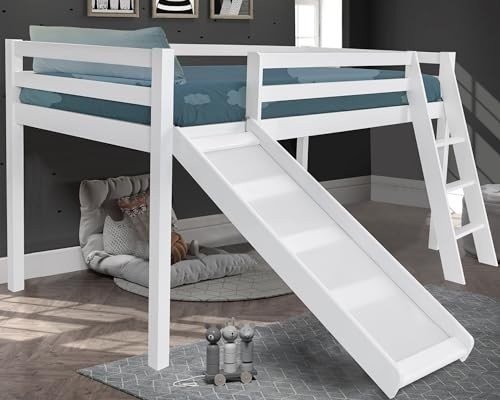Exploring Bunk Beds: A Comprehensive Guide
Bunk beds have actually long been a staple in children's bed rooms, dorms, and even homes with limited space. Not only do they offer a useful sleeping service, but they also create a fun and creative environment for children and a great space-saver for adults and households. This short article will check out whatever you require to understand about bunk beds, from types and materials to safety ideas and buying recommendations.
Tabulation
- Types of Bunk Beds
- Traditional Bunk Beds
- Loft Beds
- Triple Bunk Beds
- L-Shaped Bunk Beds
- Product Options
- Wood
- Metal
- Safety Considerations
- Purchasing Guide
- Frequently asked questions
Types of Bunk Beds
Bunk beds come in numerous styles to fit various needs and choices. Here's a breakdown of the most common types:
Conventional Bunk Beds
Traditional bunks typically feature 2 beds stacked vertically on top of one another. These beds are perfect for siblings sharing a space or for taking full advantage of sleeping space in guest spaces.
Loft Beds
Loft beds stand similarly to standard bunk beds but do not have a lower sleeping location. Instead, they frequently integrate a desk or seating area below, making them a great option for small spaces requiring multifunctionality.
Triple Bunk Beds
Triple bunk beds are developed for three occupants, with beds stacked in a three-tier configuration. These are less typical however can be an enjoyable option for big families or sleepovers.
L-Shaped Bunk Beds
With one bed positioned horizontally and the other vertically, L-shaped bunk beds are typically equipped with extra features such as desks or storage drawers and can complement corner spaces in a room.
Comparison of Bunk Bed Types
| Bed Type | Ideal Use | Description |
|---|---|---|
| Standard | Shared bed rooms or guest spaces | Two beds stacked vertically |
| Loft | Little rooms requiring multi-purpose space | Upper bed with open space beneath |
| Triple | Big households or pajama parties | Three beds stacked vertically |
| L-Shaped | Corner or flexible areas | A mix of vertical and horizontal beds |
Product Options
Bunk beds are made from different materials, with wood and metal being the most typical. Each material has its advantages and disadvantages.
Wood
- Toughness: Generally robust and can hold up against years of usage.
- Visual Appeal: Offers a timeless look that can blend with numerous designs.
- Weight Capacity: Typically stronger; can support much heavier weights.
- Drawbacks: May be more costly than metal options and can be susceptible to scratches.
Metal
- Strength: Generally light-weight and easy to move however still sturdy.
- Modern Design: Often is available in sleek styles, making it appealing for modern spaces.
- Affordable: Usually less pricey than wooden alternatives.
- Drawbacks: Can be cold to the touch in winter seasons and may not have the exact same aesthetic appeal for some buyers.
Security Considerations
When it comes to bunk beds, security can not be overlooked. Here are key security tips to remember:
- Guardrails: Ensure that the top bunk has guardrails on both sides to avoid falls.
- Durable Construction: Check for a strong construct and durable products to stand up to weight and motion.
- Weight Limit: Adhere to the maker's weight limitation for both the upper and lower bunks.
- Ladder Design: Choose bunks with a safe, easy-to-climb ladder and prevent any sharp edges or rungs.
- Age Restrictions: Most makers recommend that kids under the age of six ought to not oversleep the upper bunk.
Purchasing Guide
When looking for bunk beds, think about the list below factors to discover the best suitable for your requirements:
- Space Availability: Measure the room size and ceiling height, making sure there is adequate space for the top bunk.
- Bed Size: Decide in between twin, complete, or larger sizes based upon your needs and the size of the space.
- Style Preference: Consider the total decor of the bed room to find a suitable style.
- Ease of Setup: Look for a bunk bed that is uncomplicated to put together.
- Spending plan: Bunk beds are available in different price ranges, so determine a budget plan before beginning your search.
FAQs
1. What is the suggested age for kids to sleep on the top bunk?
Kids aged six and older are usually recommended to sleep on the top bunk to reduce the risk of falls.
2. How can Bunk Beds Sale ulli.top make my bunk bed much safer?
To improve security, make sure guardrails are correctly installed and inspect that the bed is positioned on a flat surface. Furthermore, motivate children to utilize the ladder thoroughly.
3. Can I convert a bunk bed into 2 separate beds?
Numerous bunk beds are created to be convertible. Examine the maker's specs for convertibility functions.
4. What accessories are available for bunk beds?
Typical devices include beddings, storage drawers, staircases instead of ladders, and tented canopies for an enjoyable visual appeal.
5. How do I keep my bunk bed?
Routine checks for loose screws or structural stability can help ensure safety. Dust the bed regularly and clean spills without delay to keep the products in good condition.
Bunk beds are versatile and a space-efficient service for numerous living situations, from children's spaces to guest lodgings. With many styles and materials offered, prospective buyers have a wealth of choices to consider, guaranteeing a mix of practicality and aesthetic appeals. By focusing on security and following the tips outlined in this guide, people can find the right bunk bed that matches their space and way of life, all while producing a pleasurable sleeping environment.

